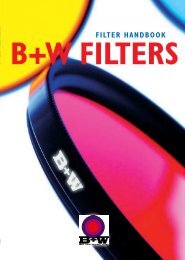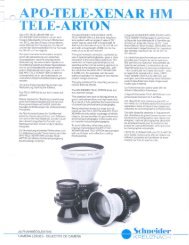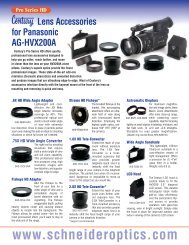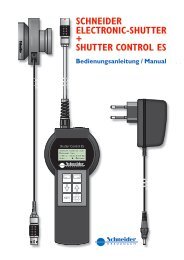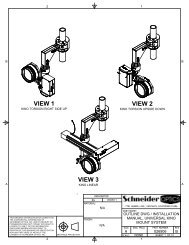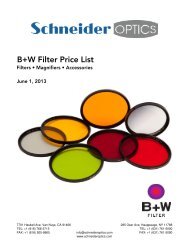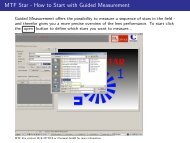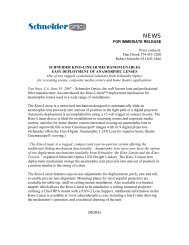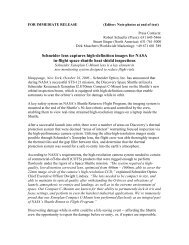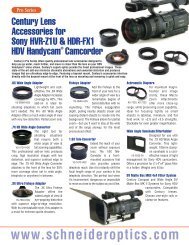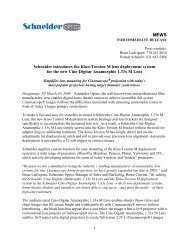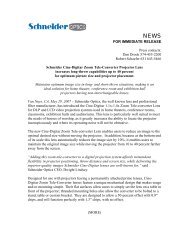DigiFOX Manual Ver 3.2 - Schneider Optics
DigiFOX Manual Ver 3.2 - Schneider Optics
DigiFOX Manual Ver 3.2 - Schneider Optics
Create successful ePaper yourself
Turn your PDF publications into a flip-book with our unique Google optimized e-Paper software.
<strong>Ver</strong>sion 1
I English<br />
II Deutsch
<strong>Ver</strong>sion <strong>3.2</strong> – eng - 2013/01<br />
Please note:<br />
New Spreading Feature!
Table of Contents<br />
1 Receiver ..............................................................................................................................9<br />
1.1 Operation / Optical Signals ...........................................................................................9<br />
1.2 Receiver Connections .................................................................................................11<br />
2 Transmitter .......................................................................................................................12<br />
2.1 Operation / Optical Signals .........................................................................................12<br />
2.2 Spreading the Lens Scales at Chrosziels Lens Control Systems ................................13<br />
3 Technical Information .......................................................................................................15<br />
3.1 Weight and Dimensions ..............................................................................................15<br />
<strong>3.2</strong> Electrical Features .....................................................................................................15<br />
3.3 Pin Assignments.........................................................................................................16<br />
3.4 Electronic calibration of the transmitter’s hand wheel - factory setup.......................18<br />
4 Declarations of conformity ................................................................................................19
1 Receiver<br />
Figure 1 - Front Side of Receiver<br />
1.1 Operation / Optical Signals<br />
1.1.1 Connector „MOTOR“ (Lemo 8 pin)<br />
Details 9<br />
This socket connects external so-called digital servo motors with incremental encoder,<br />
such as motors from the manufacturers Hedén (M26/21VE), Scorpio, Preston & Betz Tools.<br />
1.1.2 Connector „LENS FOCUS, CAM ON/OFF“ (Hirose 12 pin)<br />
For the connection of internal focus servo motors of ENG-lenses like Fujinon or Canon by<br />
means of special adaptor a cable. Also connects to the "Focus Control" socket of Panasonic<br />
camcorders DVX / HVX – types. This connector also controls the start/stop-function of video<br />
and film cameras. If ENG-lenses are connected to the receiver it will be powered through<br />
this connector and the lens outlet (10-17V).<br />
1.1.3 Connector „POWER IN, CAM ON/OFF“ (Hirose 4 pin)<br />
Used for the connection of an external power supply (voltage 10-35V). It is needed for the<br />
operation of external motors or if the receiver controls Panasonic camcorders. It also<br />
controls the start/stop-function of film- and video cameras.<br />
1.1.4 Connector „ANTENNA“<br />
Used for the connection of the receiver’s antenna, 50 Ohm, for 400 MHz band. In case of<br />
extremely bad reception due to i.e. broadband interferences, the connection between the<br />
transmitter and the receiver may be made of a standard BNC cable.<br />
1.1.5 Button „ADJUST END STOPS“<br />
When an external motor is connected, this button starts the adjust mode for the end stops<br />
of the lens. If calibration of an external motor shall be performed please proceed as<br />
follows: press the button once – the LED “FN” starts flashing fast. The motor starts the
10 Details<br />
calibration slowly and will run faster throughout the process. It is not recommended to<br />
start the calibration if the lens is positioned at one of its end stops!<br />
The button has no function in all other operation modes (internal ENG-servomotors or when<br />
using the Chrosziel light dimmer).<br />
1.1.6 Slide switch „CAM ON/OFF“<br />
Determines the mode of the start/stop function.<br />
Position left = Duration mode:<br />
As long as the camera shall run, the control contacts remain closed. They disengage<br />
when the camera shall stop.<br />
Position right = pulse mode:<br />
On most video cameras and recent film cameras, the start/stop function is normally<br />
controlled by a short impulse (approx. 1/2 sec.). Each pulse changes (toggles) the<br />
recording status to the respective other state. Make sure to synchronize to the proper<br />
position of the transmitter’s “camera start” switch!<br />
1.1.7 „FUSE“<br />
An SMD fuse (5 A surge-proof) is located behind this cap. ONLY use a suitable fuse when it<br />
is blown. NEVER short! This may cause damages on the unit or the power supply.<br />
1.1.8 LED „FN“ (FUNCTION)<br />
This LED indicates different operational states of the device:<br />
permanent on = open, no external motor connected (also on, when Panasonic DVX- & HVX –<br />
camcorder is connected)<br />
permanent off + external motor connected = end stops are calibrated (also off, when<br />
connected to ENG lenses)<br />
rhythmic slow flash + external motor connected = end stops not calibrated<br />
faster flash: calibrating and storing of the end stops with external motor in progress<br />
short blinking: The Chrosziel light dimmer is connected<br />
1.1.9 LED „LOW BATT. - RED“ (status of operations voltage)<br />
This LED indicates the status of the input voltage. LED red means input voltage 12-35V) the LED is green. For short-time voltage<br />
drops below 12V the LED is red for approx. 3 sec., even if voltage has recovered to the<br />
normal value.<br />
1.1.10 LED „HF-ERROR“<br />
Permanent flashing or constantly on indicates a reception error. The rf-channel of<br />
transmitter and receiver must be set identical. Interrupted flashing indicates interferences.
1.1.11 Cover on housing bottom<br />
Details 11<br />
Under the cover the dip switches are located for selecting the receiver channels. Four<br />
switch positions allow for setting of 16 different transmission channels.<br />
1.1.12 Switch „Motor Power – Low High“<br />
This switch is placed behind the cover on the back of the housing. It allows to adjust the<br />
maximal power for external digital motors. In position “low” the force and thus power for<br />
the motor driver is reduced to approx. 60 %. This selection is recommended for smooth-<br />
running ENG lenses or in case of an insufficient power source for the receiver. In position<br />
“high”, the motor driver provides maximal power to the external motor. This mode is<br />
recommended for heavier film lenses and/or good power supplies. The motor then reacts<br />
very dynamically due to the power reserves.<br />
1.2 Receiver Connections<br />
1.2.1 External Digital Motors<br />
External digital motors (Hedén M26VE, Scorpio SB92, Preston (DM2) or Betz Tools BTM7)<br />
are connected through the „AMOTD“-cable to the connector “MOTOR”. Power (10-35V) is<br />
applied through the 4-Pin Hirose connector. Use power cables as listed in price list for<br />
DigiFox. Do not use 24V power cables made for Genio and MagFox as the wiring is different!<br />
For the CAM start/stop function the respective cables are connected to the 12pin Hirose<br />
connector „LENS FOCUS - CAM ON/OFF“. It is possible to use a combined Power &<br />
Start/Stop cable on the „POWER IN“ connector for appropriate cameras like Panavision<br />
„PAN-A-P/CAM“.<br />
1.2.2 Internal Servomotors of ENG-, EFP-, DV- and HDV- Lenses<br />
To control ENG-lenses (without external motor) the existence of a focus motor in the servo<br />
unit is required. DigiFox will be powered and does control the lens through the cables<br />
„DFPMCD” (Canon digital), „DFPMCA“(Canon analog) or „DFPMF“(Fujinon) to the connector<br />
“LENS FOCUS”. For the camera START/STOP function the respective cables are connected<br />
to the 4Pin Hirose-connector „POWER IN- CAM ON/OFF“. No additional power supply is<br />
required, as the receiver is powered through the lens. The connection of the Panasonic<br />
DVX/HVX Camcorder is an exception. Power supply has to be made separately at connector<br />
„POWER IN“(e.g. XLR4-AL). Focus control and Start/Stop function are done through the<br />
connector „LENS FOCUS“ by using the cable „DFPMPVX“.<br />
1.2.3 Chrosziel Light Dimmer for Standard Camera Light<br />
The Chrosziel Light Dimmer for camera lights is connected through the connector<br />
„MOTOR“. Power supply has to be feed through „POWER IN“.<br />
Only operate the Light Dimmer at 12 – 15V.
12 Details<br />
2 Transmitter<br />
Figure 2 - Transmitter Unit<br />
2.1 Operation / Optical Signals<br />
2.1.1 Switch „power on/off<br />
The switch has two fixed positions. In the position “ON”, the LED „ON-Power“must be green<br />
or red. If this is not the case, check the battery and the battery cap.<br />
2.1.2 Slide switch „reverse“<br />
This switch changes the rotating direction of the motor (external or internal) in relation to<br />
the rotating direction of the hand-wheel.<br />
2.1.3 Two “set” Buttons with LED<br />
These buttons are for programming and deleting of the spreading (see topic 2.2.).<br />
2.1.4 LED „battery“<br />
This LED indicates the operational state of the transmitter. Green indicates normal state;<br />
RED indicates an almost empty battery. According to the state of the battery the transmitter<br />
switches off in the next minutes.<br />
2.1.5 LED „camera“<br />
Flashes when the „CAMERA“ switch is in position „start“. For cameras with the so-called<br />
“impulse mode”, make sure to synchronize switch position with the camera’s operational<br />
mode- see next section 2.1.6.
2.1.6 Switch „camera start“:<br />
Details 13<br />
Controls the Start/Stop function of the camera (see also topic 1.1.6 “Slide switch „CAM<br />
ON/OFF“ at page 10)<br />
2.1.7 Connector „light“<br />
Connection for the Chrosziel LED- scale illumination (please use original accessories only!)<br />
2.1.8 Cover “channel select”<br />
The dip switches for selecting the transmitter channels are located under the cover. Four<br />
switch positions result in 16 different transmission channels. Selection must be identical to<br />
the receiver.<br />
2.2 Spreading the Lens Scales at Chrosziels Lens Control Systems<br />
Before the procedure is described, one needs to understand the meaning of spreading and<br />
how it works.<br />
Please note, that the procedure explained below is a new feature existing on units delivered<br />
since January 2013 only. Units delivered before Jan. 2013 can be updated with the current<br />
software release at Chrosziel if required.<br />
In normal normal mode mode (Spreading (Spreading is is off) off) the full rotation/movement of the hand wheel/slider<br />
corresponds to 100% of the lens scale range between the two mechanical end stops.<br />
In spread mmode<br />
m<br />
ode only a part of the lens scale corresponds to the full range of the hand<br />
wheel/slider. This mode is useful if you want to adjust the lens very accurately in a specified<br />
range. For example, the scale of the lens ranges from 0,3m to infinity, but you want to work<br />
only from 20m to 30m and want to be very precise in this range. In this case, you would<br />
spread this range to the full scale of the hand controller. The one end stop then<br />
corresponds to 20m and the other to 30m.<br />
Chrosziel Lens Control Systems allow the storing of two two two independent independent spread settings<br />
which can be switched off if not needed and recalled later on by simply pressing a button.<br />
Two set buttons (A & B) are assigned to the hand wheel & slider.<br />
Store a spreading:<br />
- Hold one of the set buttons down (i.e. A), wait until the opposite LED (B) is flashing -<br />
this will happen after 1 second.<br />
- Keep button A pressed and move the hand wheel / slider in the desired range and<br />
release button A. Button A will light permanently indicating that spreading A is<br />
active now. Button B is off.<br />
- In order to switch off spreading A, simply press button A shortly (less then 1 sec) No<br />
LED is on.<br />
- In order to recall spreading A, press button A shortly (less then 1 s) - LED A switches<br />
on again
14 Details<br />
- In order to store a second spreading, repeat the procedure with button B as<br />
described for button A. Switch off and recall a spreading in the same manner by<br />
pressing button B shortly.<br />
Please also see following graphics.<br />
Chrosziel Aladin/DigiFox Electronic Spreading<br />
Normal (1:1) Mode<br />
0,3m Infinite<br />
Full lens travel<br />
0,3m Infinte<br />
Full lens travel<br />
Figure 1<br />
Hint:<br />
If applying a “zero” spreading (the hand wheel was not moved during the spreading<br />
procedure), the recall of this spreading setup can be used as a kind of preset control for a<br />
desired position.<br />
Example: Drive lens ring to 30m and press button A for more than 1 second. Release button<br />
A. Drive the lens ring to 20 m and hold down button B for more than 1 second. Release<br />
button B. Do not turn the hand wheel.<br />
Now the scale values 30m and 20m can be recalled instantly by pressing on Button A or B<br />
once.<br />
Scale travel on hand unit<br />
0% approx. 300° 100%<br />
Spread Mode:<br />
Scale travel on hand unit<br />
20m 30m<br />
0% approx. 300° 100%
3 Technical Information<br />
3.1 Weight and Dimensions<br />
Weight receiver without accessories approx. 280 g / 9.9 oz<br />
Weight transmitter (with antenna and 1 battery)<br />
approx. 600 g / 21.2 oz<br />
Max. dimensions receiver H x W x D mm/ inch<br />
(incl. connectors) approx. . 80 x 42 x 96/ 3.1 x 1.6 x 3.8<br />
Max. dimensions transmitter H x W x D mm/inch<br />
(without antenna) approx. 84 x 95 x 180 /3.3 x 3.7 x 7.1<br />
<strong>3.2</strong> Electrical Features<br />
<strong>3.2</strong>.1 Transmitter<br />
Transmitter power 10 mW an 50 Ohm<br />
Frequency range (16 Channels)<br />
<strong>3.2</strong>.2 Receiver<br />
433.900 MHz -434,9 MHz<br />
US-<strong>Ver</strong>sion:<br />
457.5 MHz-457.875 MHz<br />
Operation time with full alkaline battery (always<br />
on, dependant on capacity) approx. 24 hours<br />
Power supply through D-Cell (Alkaline, NiMh) 1.2 – 1.5V<br />
External power supply 10 V – 30 V<br />
Power input without connected ext. Motor max. ca. 130 mA at 10V / 45 mA at 30 V<br />
Power input with connected ext. Motor max. ca. 5 A (short peaks up to 7 A)<br />
HF- Sensitivity -120 dBm<br />
Fuse for supply voltage (only through „POWER<br />
IN“) 5 A surge-proof<br />
Technical 15
16 Technical<br />
<strong>3.2</strong>.3 Table of used Frequencies<br />
Positions of the code switches<br />
on the rf-modules<br />
3.3 Pin Assignments<br />
3.3.1 Connector “MOTOR“<br />
1<br />
Front View to connector<br />
Type: Lemo EGG. 1B. 307<br />
6<br />
7<br />
Frequencies<br />
EU-<strong>Ver</strong>sion US-<strong>Ver</strong>sion<br />
433.900 457.500<br />
433.950 457.525<br />
434.000 457.550<br />
434.050 457.575<br />
434.100 457.600<br />
434.150 457.625<br />
434.200 457.650<br />
434.250 457.675<br />
434.300 457.700<br />
434.350 457.725<br />
434.400 457.750<br />
434.450 457.775<br />
434.500 457.800<br />
434.550 457.825<br />
434.600 457.850<br />
434.650 457.875<br />
Pin 1: Motor –<br />
Pin 2: Motor +<br />
Pin 3: Encoder channel A<br />
Pin 4: +5V<br />
Pin 5: earth/ground<br />
Pin 6: Encoder channel B<br />
Pin 7: earth/ground
3.<strong>3.2</strong> Connector “LENS FOCUS - CAM ON/OFF”<br />
12<br />
Front View to connector<br />
Type: Hirose HR10A-10R-12SB<br />
3.3.3 Connector “POWER IN – CAM ON/OFF”<br />
4<br />
9<br />
Front View to connector<br />
Type: Hirose HR10-7R-4S<br />
1<br />
1<br />
10<br />
Pin 1: Ucam 12-15V<br />
Pin 2: earth/ground<br />
Pin 3: Uref_H<br />
Pin 4: RS232 in<br />
Pin 5: Uref_L<br />
Pin 6: Ucam 12-15V<br />
Pin 7: UFocus<br />
Pin 8: RS232 out<br />
Pin 9: CAM Relay contact 1<br />
Pin 10: CAM Relay contact 2<br />
Pin 11: CAM Relay contact 1<br />
Pin 12: CAM Relay contact<br />
Pin 1: Battery minus / GND<br />
Pin 2: CAM Relay contact 1<br />
Pin 3: CAM Relay contact 2<br />
Pin 4: Battery plus (10 – 30 V)<br />
Technical 17
18 Technical<br />
3.4 Electronic calibration of the transmitter’s hand wheel - factory<br />
setup<br />
A highly precise control of lenses regarding their end stops requires a factory setup of the<br />
transmitters hand wheel. This setup is normally made during the assembly at Chrosziel. If,<br />
for whatever reason the calibration has to be made, please proceed as follows:<br />
1) Press both set-buttons simultaneously during the whole procedure and operate the<br />
slide switch “reverse” in both directions (toggle it). Both LEDs should flash now<br />
slowly.<br />
2) Move the hand wheel gently in both directions up to the end stops while still<br />
pressing both set buttons<br />
3) Toggle the slide switch “reverse” again, the flashing set buttons should go off.<br />
4) Make a lens end stop calibration (see 1.1.5) and check the success of the calibration<br />
as follows: move the hand wheel from one end stop to the other; the motor should<br />
reach the corresponding end stops on the lens at the same time. If positioned at an<br />
end stop the motor should respond to the slightest movements of the hand wheel.<br />
5) If the result is not sufficient, repeat the procedure from step 1.)<br />
Restore Restore Restore calibration calibration on on on hand hand wheel<br />
wheel<br />
Push the two buttons simultaneously and hold both.<br />
Operate reverse switch in both directions.<br />
LEDs are flashing; keep holding the buttons and turn hand<br />
wheel from one limit to the other.<br />
Keep holding the buttons, operate reverse switch in both<br />
directions again, LEDs will stop flashing.<br />
Release set-buttons
4 Declarations of conformity<br />
Documentation 19
20 Documentation
Documentation 21
22 Documentation
24 Documentation



